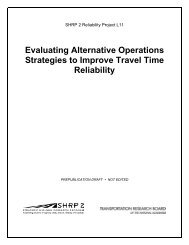Contemporary Approaches to Parking Pricing: - FHWA Operations
Contemporary Approaches to Parking Pricing: - FHWA Operations
Contemporary Approaches to Parking Pricing: - FHWA Operations
Create successful ePaper yourself
Turn your PDF publications into a flip-book with our unique Google optimized e-Paper software.
In smaller down<strong>to</strong>wns it is possible <strong>to</strong> conduct license plate occupancy and duration counts that cover all or most of<br />
the inven<strong>to</strong>ry manually. These counts can be conducted with assistance from part-time employees or interns. Ideally,<br />
counts should be updated at least once a year or after changing prices or time limits. In larger communities it may not<br />
be possible <strong>to</strong> analyze all parking facilities on a regular basis. In this situation conducting counts in sample areas that<br />
are representative of the larger community can reduce costs. LPR technology can significantly decrease the staff time<br />
required <strong>to</strong> conduct occupancy and duration counts.<br />
If a community has advanced meters but lacks space sensors, meter payment data can be used <strong>to</strong> roughly estimate<br />
parking occupancy and duration. SFpark and other agencies are developing processes for doing this in an accurate<br />
manner. Meter data can be supplemented by manual counts.<br />
Adjusting prices on an annual basis, rather than quarterly or monthly, will further reduce the staff time needed <strong>to</strong><br />
implement a performance-based parking policy.<br />
3.4 Going Forward<br />
In the future, technology will become more affordable, integrate better, and offer more opportunities for sharing data.<br />
Cities and municipalities are likely <strong>to</strong> use overlapping technologies such as parking meters, pay by phone, and LPR<br />
technology, which will likely result in increased demand for improved data integration. In turn, this should make it<br />
easier for cities <strong>to</strong> integrate parking payment and enforcement systems.<br />
Improvements in LPR technology should make the collection and tracking of occupancy and duration data easier as<br />
well, and the way in which parking data are shared is also likely <strong>to</strong> change. Online and mobile <strong>to</strong>ols that allow parkers<br />
<strong>to</strong> check on the availability and cost of parking are just beginning <strong>to</strong> appear, and their presence in the marketplace is<br />
likely <strong>to</strong> increase significantly in the future. The integration of radio-frequency identification chips that allow cell<br />
phones <strong>to</strong> communicate with nearby electronics will likely give parkers one more way <strong>to</strong> pay. The potential <strong>to</strong> integrate<br />
mobile devices in<strong>to</strong> the payment, data tracking, and parking space loca<strong>to</strong>r functions should offer significant opportunities<br />
<strong>to</strong> innovative manufacturers and communities.<br />
Mechanical parking meters ruled the world of parking for decades, negating the need for parking managers <strong>to</strong> moni<strong>to</strong>r<br />
new technologies and manufacturers. Today a parking agency must carefully examine its technology options and attempt<br />
<strong>to</strong> see far enough in<strong>to</strong> the future that its asset purchases do not become quickly outdated.<br />
C o n t e m p o r a r y A p p r o a c h e s t o P a r k i n g P r i c i n g | 13















